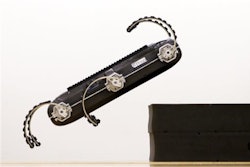By performing complex dynamic analyses more than twice as fast as Ansys, NX Nastran accelerates research into new noise and vibration solutions
Noise and vibration control through innovation
For more than 15 years, Damping Technologies Inc. (DTI) has been solving noise and vibration problems, primarily for makers of automobiles and aircraft but its products can also be found in yachts, skis and computer hard drives. DTI’s advantage is a comprehensive understanding of the dynamic properties of materials including metals, elastomers, plastics, polymers, glass enamels and composites. Using this knowledge, engineers and scientists create application-specific solutions that in most cases are lightweight, add-on countermeasures, such that the design of the customer’s part does not need to be changed.
Because the goal of DTI’s products is to suppress noise, vibrations and/or high cycle fatigue damage due to resonance response, much of the company’s R&D work involves dynamic finite element analysis (FEA). These analyses can take a long time to solve. “The type of analysis we do requires a lot of iteration and a lot of resolution in the model in terms of degrees of freedom,” explains Kristopher Notestine, manager of R&D at DTI. “A typical analysis on a very small structure can take four to eight days to run.”
With the goal of speeding these analyses, DTI decided to upgrade its hardware to an HP ProLiant system running Linux and equipped with eight CPUs and 16 gigabytes of memory. The upgrade provided the opportunity to reconsider the analysis software as well, which was Ansys at the time. “We wanted something that would run well on our new hardware, so we looked at Ansys, both Nastrans (the NX Nastran solution from Siemens PLM Software and MSC Nastran) and Abaqus,” says Notestine.
Support is important
Following a thorough evaluation process, the company chose NX Nastran for several reasons. Not only did it bring a decided speed advantage, being nearly twice as fast as Ansys during benchmarking. “NX Nastran was faster but it also came with the best support,” Notestine notes. The local distributor is netPLM in Indianapolis. “There are very good reps from netPLM, both technically and in terms of sales, and there was good teamwork between them and the people from Siemens,” Notestine says. “That gave us confidence in the support we would receive, and since then that has turned out to be the case. The follow-up support has been more regular than what we got from Ansys.”
Another deciding factor for NX Nastran was the fact that many of DTI’s customers work with Nastran. “Customers in the defense, satellite and commercial aerospace industries – they’re all using Nastran and they provide data to us in Nastran format,” Notestine adds. “When we were using Ansys, we had to convert their models to Ansys format and then make sure those models were accurate. That took from 30 to 60 days, which really put us behind. Now that we have NX Nastran, we won’t have issues with data conversion.”
More than twice as fast
Although the speed advantage with NX Nastran was evident during the evaluation process, it has actually turned out to be even better than it appeared at that time. During the evaluation process, the representatives of the various software benchmarked a simple model with direct frequency response and also ran one of DTI’s typical models containing visco-elastic material where the properties were frequency dependent. The test run with Ansys took an hour and half to solve. The same problem with NX Nastran took about 48 minutes. (The accuracy of the NX Nastran solution was verified with DTI’s test data.) According to Notestine, now that the NX Nastran is in use, it is taking about 25 percent as long as Ansys, citing one analysis that previously took 55 minutes and now takes only 12 to 14 minutes with NX Nastran.
In making the transition to NX Nastran, DTI also implemented a new pre and post-processor, the Femap solution from Siemens, on netPLM’s recommendation. “I was used to ANSYS [which also provided pre and post processing],” says Notestine. “But as I worked through the Femap tutorials, I found that it was intuitive and that I could get up and running with it quickly. It’s flexible and intuitive.”
For a company whose slogan is “noise and vibration control through material innovation,” an efficient R&D process is critical. It is key to creating new damping technology, such as DTI’s Stand- Off damping systems that deliver extremely high levels of structural damping with minimum weight addition. With NX Nastran and Femap, DTI has the FEA solution it needs to continue to provide unique damping solutions.























